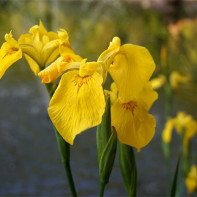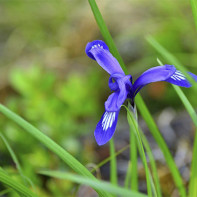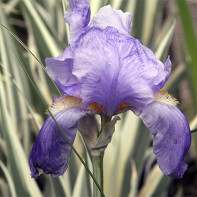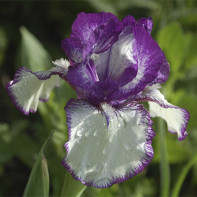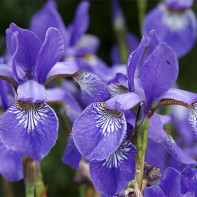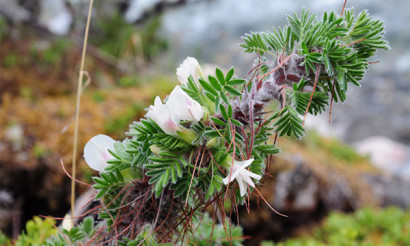Iris: medicinal properties and contraindications
An amazing plant, popularly known as the "cockerel", has been common on our planet for more than 4 thousand years. This flower is the most recognizable among gardeners around the world, because the abundance of species diversity allows it to grow on all continents. In addition to its bewitching appearance, the plant hides in itself countless healing properties and unique chemical elements that humans have been using in medicine for several thousand years.
- Chemical composition
- How it looks and where it grows
- Kinds
- Collection and storage
- The healing properties of iris
- Iris in folk medicine
- Infusion on the roots of iris, used inside
- Infusion on the roots of iris, for external use
- Explosion for the treatment of acute epidemic hepatitis
- Infusion of iris seeds for epidemic hepatitis
- The recipe for preventive infusion of fork toffee
- Alcohol tincture on the roots of iris
- Water tincture on the roots of iris
- Iris stalk laxative recipe
- Recipe for a poultice of iris leaves
- Iris Cure for Toothache
- German Iris Toothpaste Recipe
- A decoction with heavy periods
- Iris Seed Powder
- The recipe for water treatments with iris
- Types of healing compounds
- Infusion
- Tincture
- Decoction
- Tea
- Butter
- Cooking Application
- Contraindications
Chemical composition
Plant oil exudes a unique smell of violets. This is due to the content in the root of the flower of essential iris oil. Its main part is the ketone iron, and it is he who gives such a specific aroma. Rhizomes collected in the spring will contain most of this healing substance. The percentage will increase from 0.3 to 0.42.

In addition to ketoniron, in the smell of iris oil there are notes of linalool and geraniol. The composition of the unique essential oil is very rich and consists of 140 different components, including:
- methyl esters;
- aldehydes - nonyl, acetic and m-decyl;
- phenol;
- a mint smelling ketone;
- furfural.
And also acids: undecyl, oleic, lauric, benzoic, tridecyl, myristic.
In addition, a high content of starch (about 57%) and fatty oil (about 9%) were found in the roots of the plant. Resin and tannins, mucus, organic acids, isoflavone glycoside iridine are also present. Green leaves of iris contain amino acids and about 0.25% ascorbic acid.
How it looks and where it grows
Iris is a perennial herb, reaching a maximum of 90 cm in height. On slightly curly, flattened stems, up to 14 flowers can develop. Evolution has turned the stem of a plant into a rhizome. This is easy to see from the apical point of root growth (like a standard stem). Moreover, the development of vegetative buds does not occur on the roots. A powerful rhizome reaches a diameter of 3 cm. A rich brown hue begins to appear on its slice. The stems of the plant grow to the side due to the horizontal location of the root. Rhizome constantly branches, weaves and creeps, this is what becomes the main condition for the rapid development of new territories by iris.
The outlet contains wide, xiphoid leaves that reach a length of up to 2 m, and in appearance resemble calamus plates. The colors of the leaves and the stem come in many different shades, ranging from saturated green to gray. Approaching the middle of summer, the flowering phase begins in the plant. Bunches of flowers develop on tall, solid stems — usually 4–7 in one place. Perianth parts have an ovoid plate and are lowered to the bottom. They are painted pale yellow, the central part is marked with a circle of fire, and the veins are purple in color. The parts of the perianth located inside have a linear structure and a height much shorter than the column. The strings on which the stamens are located have a light shade of cream tones. The life of a flower is only about 2-6 days.
After the flower dies, an iris appears fruit. It seems to be a small box with three faces. The box is oblong and has an oval shape, which is crowned with a sharp proboscis at the very top. About 40 seeds are formed inside the capsule. All of them are large in size, have a characteristic luster and many ribs, and their color varies from the lightest brown tones to the darkest. The fruits ripen by mid-August. Iris, which can reproduce both vegetatively and by seeds (generatively), is unpretentious in leaving, grows quickly enough and rapidly leaves offspring.
Undemanding iris is quite widespread throughout the globe. Its growing areas include almost the whole of Europe (with the exception of the most northern parts), Asia, the territories of South and North America and even partially African regions. Iris growing in natural conditions prefers rather moist meadow soils, in which the content of acid substrates is as diverse as possible. A moisture-loving plant can often be found on the shores of various bodies of water, as well as in river valleys.
Kinds
On our planet, a unique plant is represented by more than 240 species. The characteristics of each depend on the climate and conditions of the places where they grow. Sometimes the differences are too great, but even the most distant from each other representatives of the healing flower have basic common similarities.
- Yellow and Kempfer. These varieties are "Japanese", grow near the water and constantly need shelter. Their leaves are very elongated and narrow, and the flowers have an unusual shape and rare colors.
- Siberian. The only representative of irises, forming a dense, strong turf. Its stems and leaves are linear, and medium-sized flowers are unusually beautiful. It has many hybrids, of which the most interesting is Spuria. All hybrids have a unique property - winter hardiness. The flower is widespread in Eurasia: from the northern regions of Italy and ending with the shores of Russian Baikal. In addition, rare habitats can be found in Turkey, the Komi Republic and the Caucasus.
- Bristly. It differs from all other representatives of the bright purple color of the flower. But the leaves have a standard xiphoid shape. Among them, stunted plants stand out, whose height does not reach even 20 cm. Their flowers are large and bright. An example is leafless iris.
- Dwarf. Dwarf iris is unique for its drought tolerance, therefore it is considered a steppe plant. Its height is small and can reach a maximum of 10, less often 15 cm. The flowers are bright yellow or lilac, and large leaves are always wide.
- Germanic (bearded). This is the most popular type of iris, among which there are three varieties: low, medium and high. This division occurs depending on the height of the stem on which the inflorescences are located. The maximum stem length can reach 80 cm, and the minimum - 20. Also division occurs according to the color of the flowers. Plain, two-toned, edged and many others are distinguished here.
- Dutch. This flower loves an abundance of heat and can hardly tolerate winter, therefore it requires shelter in the cold seasons. It differs from the others by the presence of special underground fruits instead of the rhizome. Every year, under the ground, the plant forms several large bulbs, which store an abundance of nutrients. The thick stem on which inflorescences develop can reach a maximum of 90 cm in height. On it are narrow, hard leaves that have the shape of a gutter. Flowers are painted in a single color or two colors.
- Swamp. This representative of irises is the most gigantic specimen, because its height can reach 1 m. The variety is unique not only for its size, but also for the flowering period, which begins in May and ends in June, and the color of the flowers. The "males" located on the stems always have a bright golden color, which is diluted with streaks of brown shades. The plant loves direct sunlight.However, another feature of it is that, with its heat lovingness, it still tolerates winter cold remarkably. Marsh iris is distributed throughout the globe, and in nature it can be found only in river valleys or near water bodies.
- Xiphoid. The xiphoid iris differs from its counterparts in its late flowering period. The green leaves located on the stem are always narrow and short. The flowers also have noticeable distinctive features: their inner part is very small, and the petals located on top are huge. The stem has a standard size of about 80 cm. In general, the flower has a flattened, flat shape. The distribution of the flower is limited to the territory of the Japanese islands, Korea and China.
Collection and storage
In the first year of life, plants can not be collected. During this period, they take care of him and grow up to the required age. In the second year (and preferably the third) after planting, the collection of irises begins. This should be done in the last month of summer or at the very beginning of autumn. To do this, carefully dig out the rhizome, and then thoroughly clean the roots located on the sides, rinse further with water, and then dry the longitudinally sliced fruits in the sun or in special equipment. In this case, do not forget about the constant mixing of the pieces.
It is necessary to store the obtained raw materials in a dark, dry, and most importantly - cool room. It is necessary to determine the dried parts in advance in glassware or in paper bags. Such conditions will help to keep the roots of iris for several years. The root contains the most essential oil, but despite this, the flowers of the plant are also subject to collection. After that, healing oil is obtained from them by extraction method.
The healing properties of iris
All the healing properties that iris possesses are associated with a unique essential oil and many other chemical elements that are contained in the root of the plant. Iris oil is widely used in perfumery, cosmetology and medicine. An increased content of vitamin C was found in the green leaves of the plant. It is it that slows down the premature aging of biological cells and is a very powerful antioxidant. In addition, the vitamin contained in the leaves significantly improves the immunity of any organism.
Phenolic substances contained in the root can cure various inflammatory diseases of the respiratory system, as well as the urinary system and the gastrointestinal tract. The flavonoids included in the chemical composition of the plant are able to strengthen the heart muscle and normalize blood pressure. This is due to an increase in the strength of vascular capillaries. Other chemicals of iris are able to normalize the work of the female body during menopause, replenish the missing sex hormones.
The use of iris for a variety of diseases of the liver, gastrointestinal tract and throat allows bitterness and essential oil, which are contained in the root and are a powerful antiseptic.
The plant is also widely used in cosmetology, where it also has a therapeutic effect on the skin of the face and head. Cosmetics containing iris have regenerative properties and are well suited for sensitive skin care.
In ophthalmology, parts of a herbaceous plant are also used. Its extract, which is found in many eye drops, has a bactericidal effect, thereby helping to cure even serious eye diseases.
Iris in folk medicine
Since ancient times, mankind has known the magical properties of a beautiful flower. In folk medicine, various parts of the plant are widely used, from rhizomes to seeds. Various healing tinctures for external use are made from iris, infusions and decoctions for internal use. It is also often added to toothpastes and made from the plant therapeutic lotions.
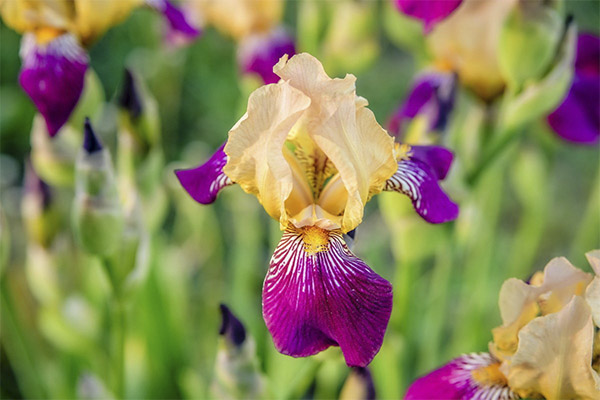
Infusion on the roots of iris, used inside
The dried root of the plant must be ground into powder. Prepare 2 full glasses of hot water, where to immerse 1 teaspoon of healing powder.Then, after thoroughly mixing the solution, leave it for a couple of hours. The present drug is used 3 to 4 times a day immediately before meals 100 ml.
Infusion on the roots of iris, for external use
Such an infusion is good for open wounds and ulcers. In such cases, healing water needs to be washed, rinsed and lotions done on sore spots. The infusion is prepared as follows. Grind the dry rhizome to a powder. Then, in 250 ml of room temperature water, preferably cold, immerse 1 small spoon of the raw material prepared in advance. After mixing the resulting infusion, leave for 9 hours in a dark place. Then he will be ready for the appropriate application.
Explosion for the treatment of acute epidemic hepatitis
To do this, boil water. Take about 10 seeds of a thin-leaved plant and pour them with a glass of boiling water. After that, turn on the stove and put on fire a prepared mixture of seeds and water. Reduce the fire to a minimum state. Thus, cook the boil for about 6 minutes. Then remove the medicine from the fire and let it brew for at least 4 hours. After this time, the broth must be carefully filtered. Only after this, the medicine can be consumed inside. This should be done as follows. Fill the glass approximately 40% with a blast. It is in this amount to use every time 2 hours after a meal and preferably from 2 to 3 times daily.
Infusion of iris seeds for epidemic hepatitis
Grind the seeds of thin-leaved iris into powder. Then pour one third of a small spoonful of iris powder with a glass of ice water. Next, send the mixture to the fire, where it should be brought to a boil. As soon as the medicine begins to boil, take time. After boiling, cook the solution for exactly another 10 minutes. Allow the finished product to cool and infuse for one hour, only after that it can be used for its intended purpose. A filtered broth should be taken half an hour before a meal. Each time you should drink one third of the glass. Do it in the morning, at lunch and in the evening.
The recipe for preventive infusion of fork toffee
To prepare the next infusion, you need to take one stem of the forked iris. First, cut the dried stem into small pieces, and then grind it to a powdery state. Next, place 4 g of powder in a glass or in any other dish, most importantly the same volume, and pour hot water. Boil the resulting mixture for 2–4 minutes. Then infuse the broth for at least an hour and then filter it well. Use the resulting preventive infusion no more than 4 times a day. Do it as follows: each time fill a glass halfway, add a tablespoon of honey there, mix thoroughly together and consume it inside.
Alcohol tincture on the roots of iris
For the preparation of alcohol tincture, it is important to use only the dug up roots of the plant. They must be thoroughly washed and then chopped using a meat grinder. The resulting slurry in a ratio of 1/1 is mixed with vodka or a solution of alcohol (not higher than 70 degrees). Send fresh alcohol tincture to storage in a refrigerator or in a dark, cold place for at least 3 weeks. When the medicine is completely ready, it can be used in two ways.
- It is necessary to take a gauze cloth and cut a piece from it to make a bandage. Then moisten it thoroughly in alcohol tincture and wrap its legs in the place where there are spurs, while covering the cellophane film on top. Leave a sore spot in this condition for the whole night. In the morning, remove the bandage. And in the evening, before going to bed, carefully lubricate the sore spot with petroleum jelly and be sure to massage.Such treatment should be carried out for three weeks, alternating with a healing dressing and massage every other day.
- Reception of alcohol tincture on the roots of iris is also useful for patients with tuberculosis or bronchitis. To do this, before using 1 teaspoon of tincture, add to a glass of chamomile tincture. The resulting infusion should be used to gargle, which should be done every 2 hours.
Water tincture on the roots of iris
Dry the roots of the plant into small pieces, which then grind into a healing powder. Then in a thermos send 2 tablespoons with a bunch of the resulting powder. Fill the thermos with boiled water and close. The mixture should be infused overnight. Then filter it qualitatively. Now the drug is ready for use. There are several ways to use the healing infusion of iris.
- Used for severe coughing. The patient needs to drink one third of a glass of tincture in the morning, at lunch and in the evening.
- Anyone who has dropsy or has multiple edema will also help tincture on iris. People need 3 times a day to take inside 1 tablespoon of the drug.
- People with a wide variety of tumors and mastitis will benefit from gauze dressings or cotton pads thoroughly moistened in a solution. They must be applied to the site of the disease for at least 40 minutes.
Iris stalk laxative recipe
To prepare a universal laxative, you need one small young plant stem. It must be well cut into small pieces and add half a teaspoon of honey. Take the resulting slurry inside.
Recipe for a poultice of iris leaves
Poultice from iris leaves very well help to remove corns on hands and feet. For this, the leaves of pale iris are used. The recipe is extremely simple. It is only necessary to finely chop the leaves and scald them with boiling water. Then put the plant pieces on the sore spot for at least 3 hours. It is important not to forget to repeat this procedure 2 more times.
Iris Cure for Toothache
To prepare this drug, you need to take 40 g of dried roots of water iris. Grind the raw materials and fold them into a suitable container. On top of the powder pour one glass of red wine. Mix everything thoroughly and clog the dishes. After this, send the mixture for a whole week to a dry, dark place, such as a closet. In this case, it is important not to forget to chat the mixture in the dishes daily. When the time is up, the solution is carefully filtered with ordinary gauze, which is folded in several layers. Pass liquid through it into another clean container. Often, you should not use the finished medicine. Also, it can not be used for prevention. Use is allowed only if the person has a toothache. In this case, the patient should take about 20 ml of infusion every 3 hours by mouth.
German Iris Toothpaste Recipe
At the very beginning, it is necessary to mix well 4 g of cellulose and 40 ml of glycerin. Then, from the dry roots of iris, make a powder, grinding the previously crushed pieces into dust. To prepare the paste, you need 20 g of powder. Mix it with 20 drops of essential oil. Now combine the resulting mixture into one and thoroughly knead all the ingredients. Gently mixing the mixture, slowly pour 70 ml of boiled water into it. After that, if desired, 200 ml of preservative can be added to the paste, as well as 0.4 ml of lactic acid. Mix well again, the pasta will be ready. Thanks to the components that make up the toothpaste, it will have light abrasion.
A decoction with heavy periods
To prepare a healing drink, you need 50 g of pre-ground iris root powder. Pour them in a glass of cold, purified water.Next, send the solution to a water bath for 15 minutes, after which it will be ready for thorough filtration. Next, add the broth to its original volume by adding boiled water. The contents of the glass divided into three equal parts. In the morning, at lunch and in the evening, consume one part of the mouth inside with slow, measured sips. Such preventive treatment will help to avoid excessive discharge of blood from the body.
Iris Seed Powder
To prepare a medicinal powder, it is necessary to use the seeds of a German iris. Pour the grains taken out of the box into a porcelain mortar and knead thoroughly to a powder. Then they sprinkle bleeding, open wounds.
The recipe for water treatments with iris
About 10 drops of essential iris oil must be added to the bathtub drawn up with hot water. It is important not to forget to pour 30 drops of emulsifier. Admission of such a bath helps the body to relax, has a regenerative effect on the skin.
Types of healing compounds
Healing herbaceous plant is used in a wide variety of species, compositions and mixtures. The preparation of a medicinal product from iris depends on the disease that must be eliminated. Such a wide range of applications of the plant depends on its unique chemical composition, which includes many useful elements.
Infusion
Infusion on various parts of the iris can be used both internally and externally. External use is possible in the form of lotions and washing wounds and ulcers, which could get an infection. The infusion is taken orally for cancer, diseases of the stomach and thyroid gland.
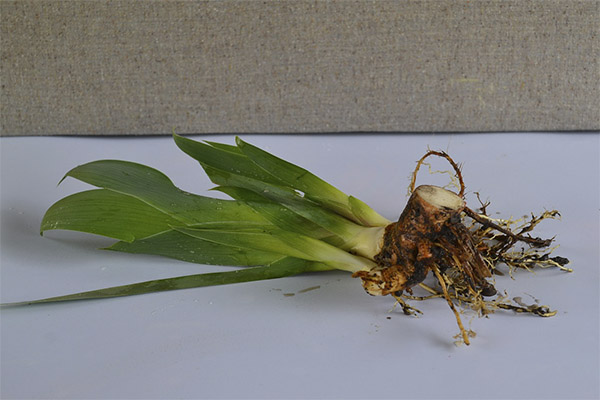
Tincture
Tinctures of iris are alcohol or water. They are used to treat a variety of diseases of the respiratory tract and organs, with acute bronchitis, pneumonia and asthma. Also, tincture has a very good hemostatic effect.
Decoction
Healing decoction of iris helps with a variety of diseases. Most often it is used for toothaches. To do this, rinse the mouth with a healing broth. The broth saves from dandruff on the head, cancer, various tumors.
Tea
The most common use of iris tea is indicated for those who have chest problems or mastopathy. In this case, tea has a therapeutic effect.
Butter
Iris oil provides significant help for serious diseases of the gastrointestinal tract and liver, stomach ulcers, colic, gastritis and even gallstones.
Cooking Application
The wonderful aroma of violets exuded by the roots of grassy iris made this wonderful plant one of the ingredients in various dishes. Most often, dried and powdered roots of iris are used in the manufacture of various confectionery products. Baking flour and starch are also made from the root. But, in addition to this, the range of application of the plant in cooking is very wide. The powder is part of many spices for fish and meat, it is a unique spice that can emphasize an amazing taste. Flower extract is often used as a flavoring, adding it to any drinks, ice cream, candied fruit, preserves and jams. Widespread use of iris in the distillery.
Despite such a wide range of applications in cooking iris, it is most often used in exclusive restaurants. After all, the plant is extremely specific and requires special treatment, owned by the chef.
Contraindications
The main factor by which you should abandon the use of various medications, which include any kind of iris, will be individual intolerance. However, in addition to this, it is worthwhile to refrain from those who have high blood coagulability. And also iris can harm young children, pregnant women and women who are in lactation.
«Important: all information on the site is provided exclusively in fact-finding purposes. Before applying any recommendations, consult with a profile specialist. Neither the editors nor the authors are liable for any possible harm caused materials. "

